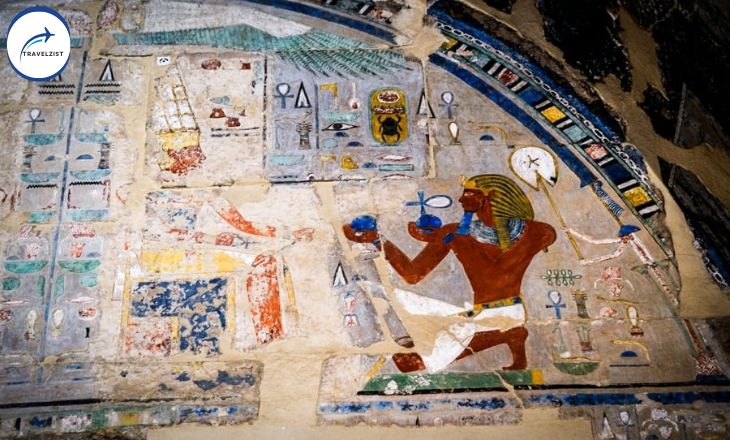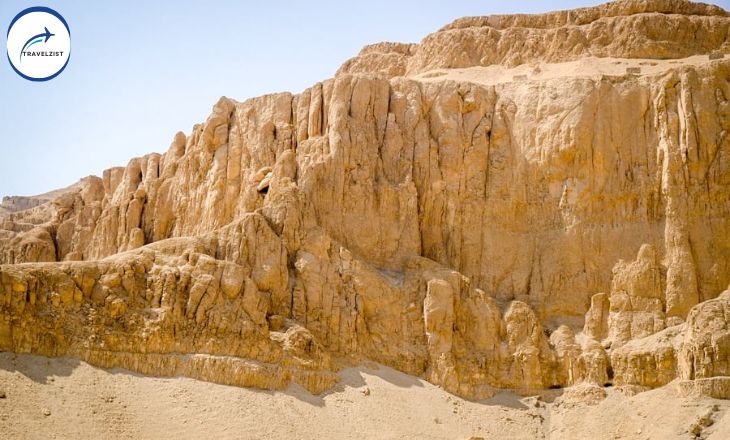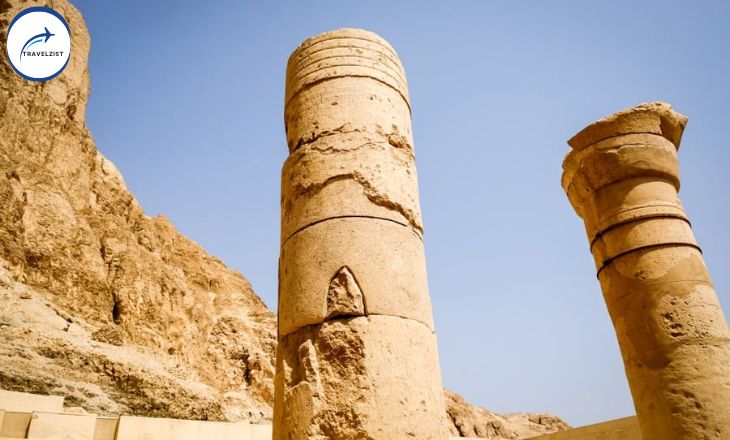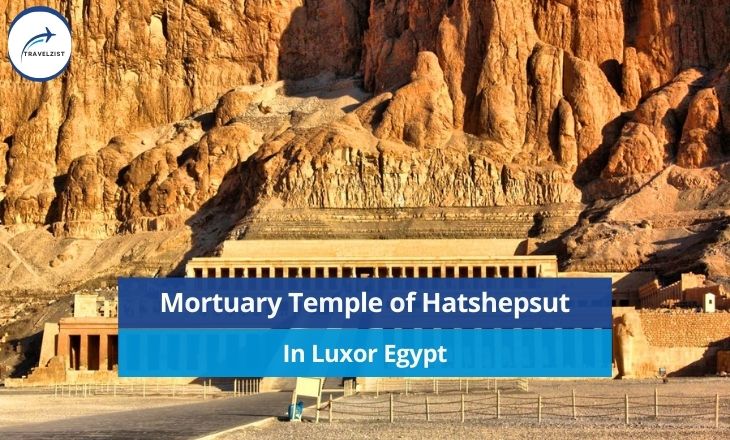The Mortuary Temple of Hatshepsut is located in Luxor, Egypt, surrounded by cliffs. It is a symbol of female empowerment and ancient architecture. Queen Hatshepsut, one of Egypt’s mysterious pharaohs, ruled during this time. The temple has tall pillars and detailed carvings that show a mix of power, beauty, and spirituality. It reflects the achievements and culture of ancient Egypt.
The terraces of the temple blend with the natural surroundings, and hidden sanctuaries add to its mystery. The temple holds stories of the past that are still alive in its stone halls. Let’s explore this ancient structure and uncover its secrets, which continue to fascinate historians and visitors.
History Of Hatshepsut Temple
The Mortuary Temple of Hatshepsut was commissioned by Queen Hatshepsut, the first female pharaoh of ancient Egypt. Construction began in 1473 BC and lasted for 15 years. The original temple featured lush gardens, reflecting pools, and intricate artwork that have mostly disappeared over time.
Although Queen Hatshepsut was not buried at the mortuary temple but in the Valley of the Kings, her stepson Thutmose III destroyed many images and statues within the temple out of jealousy.

Since then, major excavation efforts and restoration works have been carried out to restore the temple to its current state, allowing visitors to glimpse into the grandeur of this impressive structure and learn more about Queen Hatshepsut’s reign in ancient Egypt.
Visiting Hatshepsut Temple
The magnificent Queen hatshepsut mortuary temple is a grand 3-story structure adorned with impressive statues, intricate columns, and ancient hieroglyphs. Nestled in a towering 300m tall canyon, it stands as a picturesque marvel of ancient Egyptian architecture.
The temple’s design showcases exquisite beauty and remarkable symmetry, with fascinating inscriptions depicting scarab beetles and narrating the intriguing tale of the iconic queen.

Visitors can immerse themselves in its wonders during a leisurely exploration lasting about 60 minutes, making it an ideal morning activity for a memorable visit. It is highly recommended to start your journey early to avoid the scorching heat and large crowds, allowing for a more peaceful and enriching experience within this historical gem in Egypt.

Hours & Entrance Fees
Hours: 6 AM – 5 PM
Entrance Fee:* 140 EGP
Students: 70 EGP with ID
Bus: 2 EGP**
Photos: Free**
Hatshepsut Temple Location
Visitors can explore this impressive architectural marvel which features terraces, colonnades, and statues depicting various scenes from Hatshepsut’s reign. The temple’s location provides a stunning backdrop against the rugged cliffs and desert landscape, making it a must-see attraction for anyone interested in Egyptian history and culture.
How To Get There
The Hatshepsut Temple, located in Luxor, Egypt, is a popular tourist destination accessible via 1-hour flights or a 9-hour train ride. Flights to Luxor can be easily booked on Skyscanner for around $90 USD, offering convenience for travelers looking to visit this historical site.

Upon arrival in Luxor, finding a driver to take you to the temple is a straightforward task as they are readily available near the west bank ferry terminal. It’s important to be aware that touts in Luxor can be quite persistent in offering their services and trying to guide visitors towards specific vendors or attractions.
Best Hatshepsut Temple Tours
Tour companies provide convenient and stress-free trips to the ancient temples of Luxor, allowing visitors to explore its historical wonders without the added hassle of planning.
One popular tour option is the Luxor day tour, which includes visits to iconic attractions such as the Colossi of Memnon and Karnak Temple.

These companies also offer tours to various other destinations, catering to a wide range of interests and preferences. By choosing a reputable tour company, tourists can enjoy a well-organized itinerary and expertly curated experiences during their travels.
More Egypt Travel Tips
Visiting the Queen Hatshepsut Temple in Luxor, Egypt, it is recommended to check out the Egypt Travel Guide for more detailed information on how to plan your trip effectively. The temple is an impressive ancient structure located on the west bank of the Nile River. Ensure you wear comfortable clothing and shoes as exploring the temple complex requires a fair amount of walking.
Among the best things to do in Egypt are visiting the iconic Pyramids of Giza, exploring the ancient temples in Luxor, cruising down the Nile River, diving in the Red Sea and discovering vibrant markets in Cairo.
Where To Stay
You can stay at a hotel or resort by the Nile River in Luxor. This location is close to the temple and other attractions like the Valley of the Kings and Karnak Temple. Another option is to stay on the West Bank of the Nile, which is peaceful and has nice views of the Theban Mountains.

Many hotels and guesthouses in this area offer a quiet place to relax after sightseeing. Whether you stay on the East or West Bank, both areas have different choices for all budgets and preferences, making sure you have a comfortable stay when visiting Queen Hatshepsut Temple.
Conclusion
The Mortuary Temple of Hatshepsut in Luxor, Egypt stands as a testament to the power and innovation of ancient Egyptian architecture. The temple’s unique design, blending seamlessly with the surrounding cliffs, showcases the artistic and engineering prowess of its builders. Its historical significance as a tribute to one of Egypt’s few female pharaohs adds an extra layer of intrigue to this already impressive structure.
Visitors today can marvel at its grandeur and imagine the rituals and ceremonies that once took place within its walls. To truly appreciate the rich history and beauty of this temple, a visit to Luxor is a must for any history enthusiast or traveler seeking a glimpse into Egypt’s glorious past.
FAQs
Where was Queen Hatshepsut Buried ?
Hatshepsut, one of ancient Egypt’s most famous pharaohs, was buried in the Valley of the Kings near Luxor. Her tomb, designated as KV20, was discovered in 1903 by archaeologist Howard Carter. The tomb is located beneath a sheer cliff face and contains elaborate decorations and artifacts that reflect Hatshepsut’s powerful reign.
Where is the Mortuary Temple of Hatshepsut
The temple is situated beneath the cliffs at Deir el-Bahari and is a remarkable example of ancient Egyptian architecture.
Where is the Temple of Hatshepsut Located?
The Temple of Hatshepsut, also known as Djeser-Djeseru, is located in Egypt’s Valley of the Kings, near the modern-day city of Luxor. This impressive mortuary temple was built for Queen Hatshepsut, one of the few female pharaohs in ancient Egypt’s history. The temple is situated at the base of towering cliffs and is a striking example of ancient Egyptian architecture.
What are the Features of Hatshepsut’s Mortuary Temple?
The temple also includes a large courtyard with impressive colonnades featuring statues and reliefs depicting scenes from Hatshepsut’s life and achievements. One of the most famous features of the temple is the Chapel of Hathor, dedicated to the goddess Hathor and adorned with beautiful depictions of Hatshepsut offering gifts to the gods.
- El Nido Palawan Island Travel Guide For The Philippines - 29 May 2024
- Uluwatu Bali: 20 Best Things To Do In Uluwatu - 28 May 2024
- Breckenridge Troll Hike: Isak Heartstone Location & Directions - 24 May 2024

